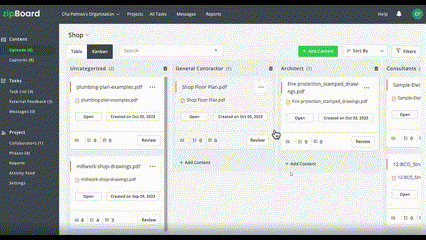Risk Management in Architecture: How to Mitigate Risks and Protect Your Firm
29 Apr

Table of Contents
ToggleArchitecture projects are prone to risks of different types and severities. These risks can come in the form of threats and opportunities. While you cannot eliminate risks, you can manage and mitigate them. That is where risk management in architecture comes in.
In this article, we discuss the basics of risk management for architects in the AEC industry and how to mitigate these risks to prevent you, your firm, your clients, and your stakeholders from litigation.
Our job as architects is to help our clients reduce their risk. We need to understand the unforeseen issues that may impact the construction and make sure they have cash reserves to cover them as construction unveils unknown circumstances.
Michael Bahr, AIA, Project Architect and Director of Client Relations, Plunkett Raysich Architects, LLP
The Basics
What is Risk?
According to Patrick Weaver in the Project Management Body of Knowledge (PMBOK®) Guide, risk is “an uncertain event or condition, that if it occurs, has a positive or negative effect on a project’s objective”. This means risks could pose as threats or opportunities to any project.
Architecture risks occur at different project phases, including the pre-agreement phase, proposal stage, architect-client agreements, bidding and contract award, contract administration, and even post-construction.
Some of the common risks architects and firms face include:
- Inadequate Client & Project Selection: Choosing projects that don’t align with expertise or difficult clients.
- Unclear Contract Formation: Unwritten agreements or inappropriate standard forms leading to disputes.
- Overpromising in Proposals: Setting unrealistic expectations and facing project difficulties later.
- Unclear Roles & Responsibilities: Poorly defined roles, leading to confusion, delays, and cost overruns.
- Design Errors & Omissions: Costly rework, safety hazards, and project delays.
- Miscommunication During Design: Design revisions, project delays, and compromised design intent.
- Inexperienced Contract Administrator: Missed deadlines, cost overruns, and unresolved issues.
- Unclear Project Scope: Disputes with clients and contractors due to poorly defined project scope.
- Unforeseen Project Delays: Permitting delays, labor shortages, and other external factors impacting timelines.
- External Factors Beyond Control: Material price fluctuations, weather disruptions, and regulatory changes impacting the project.
Find more examples in the table below:

What is Risk Management?
Risk management deals with strategically putting measures in place to identify, assess, and mitigate potential risks that could impact your project’s success, budget, and reputation/that of your practice. This mitigation will often include preventing or controlling risks.
Note: It’s important to take a strategic approach to risk management. Follow a guided process to lead you to effective solutions. For instance, you need to understand your architectural process, to help you identify possible risks.
This data will then give you the information you need to select the tools or strategies you need to put in place to prevent or control risks.
Don’t start by selecting tools when you don’t even know the risk you’ll likely deal with, and the information required to help you implement the right risk management strategies, frameworks, and tools at your firm.
Why is Risk Management Crucial for Architects in the AEC Industry?
Without risk management, you’re setting up your stakeholders and yourself for many issues and legal suits which will cost you time, money, potential clients, and your reputation.
Risk management helps:
1. You become aware of factors that could impact your project. If they’re opportunities, you find ways to ensure you take advantage of them. Threats? Find ways to control or prevent them.
2. You make risk-intelligent decisions. Being aware helps you to plan and make data-driven decisions for the success of your project.
3. Ensure risk accountability. So many stakeholders are often involved in architecture projects. Sometimes, the lines between who owns what is blurred. However, risk management will help assign roles and responsibilities to appropriate stakeholders and how each may be liable to potential risks if they do not go according to the contract or for some other reasons.
4. Ensure readiness. When risk management is implemented, everyone will be ready to face the project and problems that arise head-on. You know what to expect, how to prevent or control it when it happens. Because you have a plan!
How to Manage Risks and Minimize Litigation Potential - Steps
Risk management tactics may differ from firm to firm. However, the steps to manage risks and minimize litigation remain the same across the board:
1. Identify the Risk (Identification)
Collaborate with stakeholders to identify potential risks early in the project’s lifecycle. The purpose of this is to help you identify both opportunities and threats that may impact the project.
To do this, consider your internal procedures for the practice, the external environment that your practice operates in – that is, the AEC industry as a whole, government organizations, regulators, etc – and finally the project.
What are the goals? What are the objectives? What is expected?
Answering these questions will help you identify potential risks you need to mitigate.
During risk identification, you can organize workshops and host brainstorming sessions to identify possible risks.
2. Assess the Risk (Assessment)
This stage is also known as risk analysis.
Here, you dive deep into the risks you identified in Step 1 and explore the likelihood and impact of those risks against certain project and practice objectives, as well as factors like project schedule, budget, design, etc.
Examples of risk assessment tools to employ include a risk matrix to help categorize risks based on their likelihood and severity
3. Create a Risk Mitigation Plan (Mitigation Planning)
Now that you know possible risks and their likelihood of impact on project objectives, it’s time to devise strategies and tactics to address them.
Risk mitigation planning or treatment could include:
- Avoidance: suggesting alternative materials
- Mitigation: including buffer timelines
- Transfer: adding specific insurance clauses
- Acceptance: incorporating flexibility into designs
Keep in mind: the goal here is to optimize value and return while keeping risk within acceptable levels or limits of tolerance and appetite.
4. Implement Strategies to Monitor and Control Risks (Monitoring and Control)
After step 3, you could say you’re done, but risk management doesn’t end there. You need to go a step further by putting processes in place to monitor risks at your firm continuously – throughout the project.
These can include monitoring strategies like regular risk reviews, project status meetings, and maintaining a central risk register. Additionally, consider control processes like developing action plans, establishing change management procedures, and tracking the effectiveness of mitigation strategies you implement.
This will help you adapt mitigation strategies when needed.
5. Communicate Regularly (Communications and Attestations)
Finally, you want to implement processes to manage communications with relevant stakeholders in the risk management process. This will enable stakeholders to acknowledge receiving critical information or updates on risk mitigation strategies.
Attestations help ensure that all stakeholders are aware of identified risks, mitigation plans, and any changes to the risk landscape. This promotes transparency, accountability, and quicker responses to emerging issues.
This can be scheduled ahead of time, or be held on an ad-hoc basis when some risk conditions are triggered. That’s why having a plan in place is crucial.
Examples of communication and video conferencing platforms to consider include Microsoft Teams, Zoom, Google Meet, and Slack.
And there you have it!
How to Mitigate & Reduce Risk at Your Architecture Firm
Successful architecture projects rely heavily on effective risk management. By implementing proactive strategies at each stage, architects can minimize the likelihood and impact of potential issues.
Find below a breakdown of the common risks architects face at various project stages, along with mitigation and reduction strategies, with examples of tools for implementation.
Pre-Agreement Phase
Client & Project Selection
- Develop checklists that evaluate project type, budget, client expectations, and potential constructability challenges.
- Use project selection scoring matrices that assign points based on key criteria.
- Conduct client interviews to assess communication style, experience with construction, and budget flexibility.
Subconsultant Selection
- Maintain a qualified vendors list based on past performance and expertise.
- Request references and check past project experience.
- Consider pre-qualification questionnaires to assess subconsultant capabilities.
Tools: Enterprise risk management systems like Riskonnect and Archer GRC, project selection templates, and reference check forms.
Request for Proposal / Proposal Stage
- Conduct a feasibility study to assess project scope and identify potential constraints.
- Involve key team members in proposal development to ensure realistic timelines and deliverables.
- Use risk registers to capture potential project risks and propose mitigation strategies.
Contract Review
- Partner with legal counsel to thoroughly review client-provided contracts.
- Leverage industry-standard contract review checklists to identify areas of concern.
- Consider using risk rating matrices to assess the severity of potential contractual risks.
Tools: Contract review software, risk register templates, industry-standard checklists.
Client-Architect Agreements
- Develop clear and concise written agreements outlining project scope, roles, responsibilities, and communication protocols.
- Use industry-standard architectural service agreement templates as a starting point.
- Conduct workshops with clients to discuss expectations and ensure alignment.
Tools: Architectural service agreement templates, project communication plan templates.
Design & Documentation
Design Errors & Omissions
- Implement design reviews at key project milestones with internal and external stakeholders.
- Employ computer-aided design (CAD) software like Autodesk Revit with automated clash detection features.
- Use design review and approval tools like zipBoard to streamline the feedback process.
- Encourage a culture of open communication to identify and address design issues early.
Document markup tools in zipBoard
Miscommunication & Client Feedback
- Establish clear and documented communication protocols with clients.
- Use visual aids like renderings and physical models to enhance client understanding.
- Implement a version control system to track design revisions and manage client feedback.

Bidding & Contract Award
Litigation from Bidders
- Develop clear and unambiguous bidding documents outlining selection criteria and evaluation process.
- Conduct a pre-bid meeting to address bidder questions and clarify project requirements.
- Maintain a detailed record of the bidding process and selection rationale.
Contract Administration
Inexperienced Contract Administrator
- Assign qualified and experienced personnel to manage contracts.
- Provide contract administration training for staff.
- Use contract administration checklists to ensure all key tasks are addressed.
Unapproved Subcontractor Substitutions
- Include clauses in contracts requiring written approval for subcontractor substitutions.
- Conduct pre-qualification of potential subcontractors before awarding subcontracts.
- Maintain clear communication with the contractor regarding subcontractor selection.
Tools: Contract clause templates for subcontractor approval, subcontractor pre-qualification questionnaires.
Post-Construction
Warranty Claims
- Maintain a comprehensive recordkeeping system for all project documents and warranties.
- Conduct a final inspection to identify and document any deficiencies before project handover.
- Clearly define warranty terms and responsibilities in construction contracts.
Tools: Document management systems, final inspection checklists, construction contract templates with warranty clauses.
Recommended Reading:
External Risks
Material Price Fluctuations & Regulatory Changes
- Monitor industry publications and economic forecasts to anticipate potential price changes.
- Include escalation clauses in contracts to account for unforeseen material cost increases.
- Stay informed about relevant building codes and regulations and incorporate them into project plans.
Weather Disruptions
- Analyze historical weather data for the project location.
- Develop contingency plans to address potential weather delays.
- Consider incorporating insurance against weather-related project disruptions.
Project Management Risks
Project Delays
- Utilize critical path method (CPM) scheduling to identify and manage critical project tasks.
- Develop risk registers to track potential delays and mitigation strategies.
- Maintain open communication with all project stakeholders to ensure timely issue resolution.
Tools: Project scheduling software, risk register templates, project communication plan templates.
Unclear Communication
- Establish clear and documented communication protocols for all project stakeholders.
- Conduct regular project meetings to discuss progress, identify issues, and ensure alignment.
- Use project management software with communication and collaboration features like Monograph, Newforma, and zipBoard.
Client Expectation Management
- Develop a clear project brief that outlines project goals, budget, and timelines.
- Conduct client workshops to discuss expectations and ensure alignment throughout the project lifecycle.
- Maintain regular communication with clients to address concerns and manage expectations proactively.
Tools: Project brief templates, client workshop facilitation guides, project communication plan templates.
Recommended Reading:
Benefits of Robust Risk Management in Architectural Practice
Successfully implementing risk management strategies will help:
- Minimize project delays and cost overruns.
- Reduce the likelihood of design errors and rework.
- Enhance client satisfaction through clear communication and project delivery.
- Improve risk allocation and protect architects’ professional liability by minimizing the risk of litigation.
- Foster a proactive and collaborative project environment.
How Document Management and Collaboration Software like zipBoard Help Mitigate Risks at Your Firm
Effective communication and collaboration are paramount throughout the architectural project lifecycle. Misunderstandings, information silos, and slow decision-making can all lead to costly mistakes and project delays. Fortunately, centralized document management and collaboration tools like zipBoard can significantly mitigate these risks by fostering a more transparent and efficient workflow.
Here’s how zipBoard can help you reduce risks:
Unify Communication between Internal and External Stakeholders
zipBoard provides a central platform for all project stakeholders, including architects, engineers, contractors, and clients, to communicate and share information in real-time. This eliminates the need for multiple communication channels and reduces the risk of missed messages or misunderstandings.
Streamline File Sharing and Feedback
The browser-based software integrates seamlessly with your document management software or cloud store. This eliminates the need for time-consuming file exports and imports, reducing the risk of errors caused by using outdated or incorrect versions of documents.
Recommended Reading:
Ensure Real-Time Markup and Feedback
zipBoard allows users to directly markup drawings, specifications, and other project documents. This streamlines the feedback process and ensures everyone is working on the latest version of the documents. Thereby, reducing the risk of errors caused by miscommunication.

Version Control and Audit Trails
zipBoard automatically tracks changes made to documents using Kanban boards and table views. Thereby, allowing you to view previous versions if necessary.
This enhances document control, eliminates confusion over outdated documents and mitigates the risk of errors caused by using the wrong version.
Additionally, audit trails document all changes made to designs in one place and provides a clear record of decision-making and mitigating the risk of confusion or disputes.

Task Management
zipBoard’s task management and project organization features allow architects to assign tasks, set deadlines, and track progress. This promotes accountability, improves team coordination, and helps architects and the entire AEC team stay on top of project schedules, reducing the risk of missed deadlines and project delays.

Improved Accessibility and Transparency
Project documents and discussions are stored centrally in the cloud-based platform, accessible to authorized users from anywhere at any time.
This transparency fosters trust among all stakeholders (including clients) and reduces the risk of information gaps that could lead to delays or errors.
Enhanced Coordination and Decision-Making
By streamlining communication and providing a central platform for document sharing and feedback, zipBoard facilitates better coordination among project teams. This allows for faster decision-making and reduces the risk of delays caused by slow approvals or lack of clarity.
Reduce Architecture Risks at Your Firm with zipBoard
Start your free trial or book a demo today so that we can create a tailored solution for you.
Book DemoStart Free TrialAuthor’s bio:
Dorcas Kpabitey is a Content Marketing Specialist at zipBoard. She began her content marketing journey alongside her BA in Political Science and Spanish at the University of Ghana. If she is not tapping away at her keyboard or spending time on Twitter and LinkedIn, she spends her day reading articles, newsletters and books.
Related Post
Recent Posts
- Document Versioning: What It Is, Benefits, Best Practices, and Tools July 18, 2024
- Improved Document Version Control in zipBoard! Add Multiple File Versions. Never Lose Track of Any July 18, 2024
- 5 Tips and Tools for Effective Collaborative Video Editing July 10, 2024
- A Guide to Understanding Micro-interactions for Improved User Experience July 8, 2024
- 9 Strategies to Track Project Progress and Ensure Timely Completion July 1, 2024
©️ Copyright 2023 zipBoard Tech. All rights reserved.


